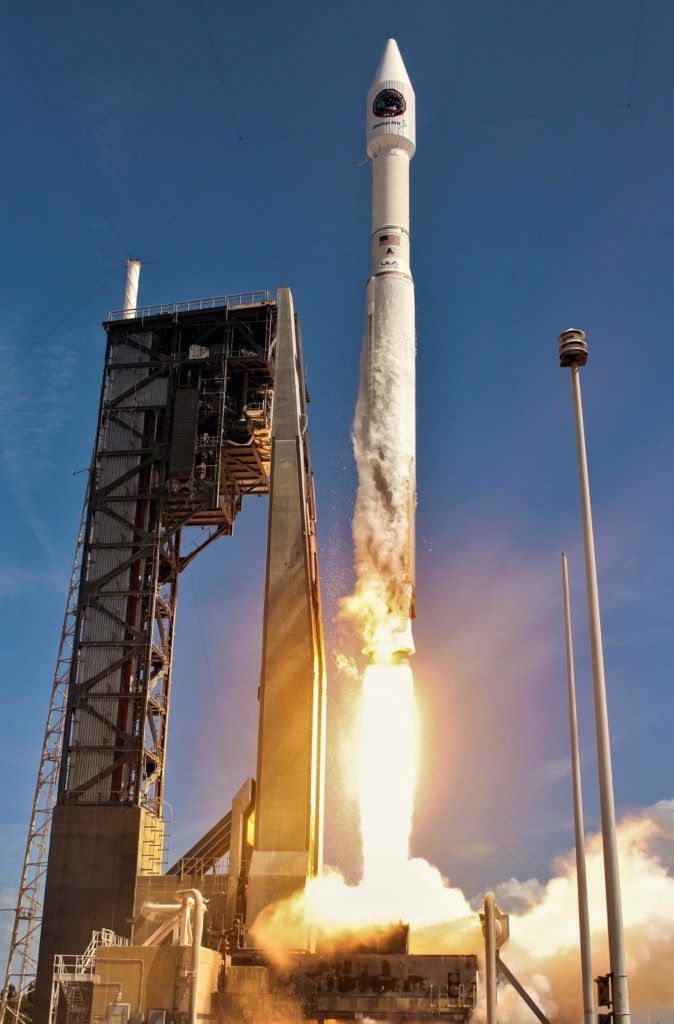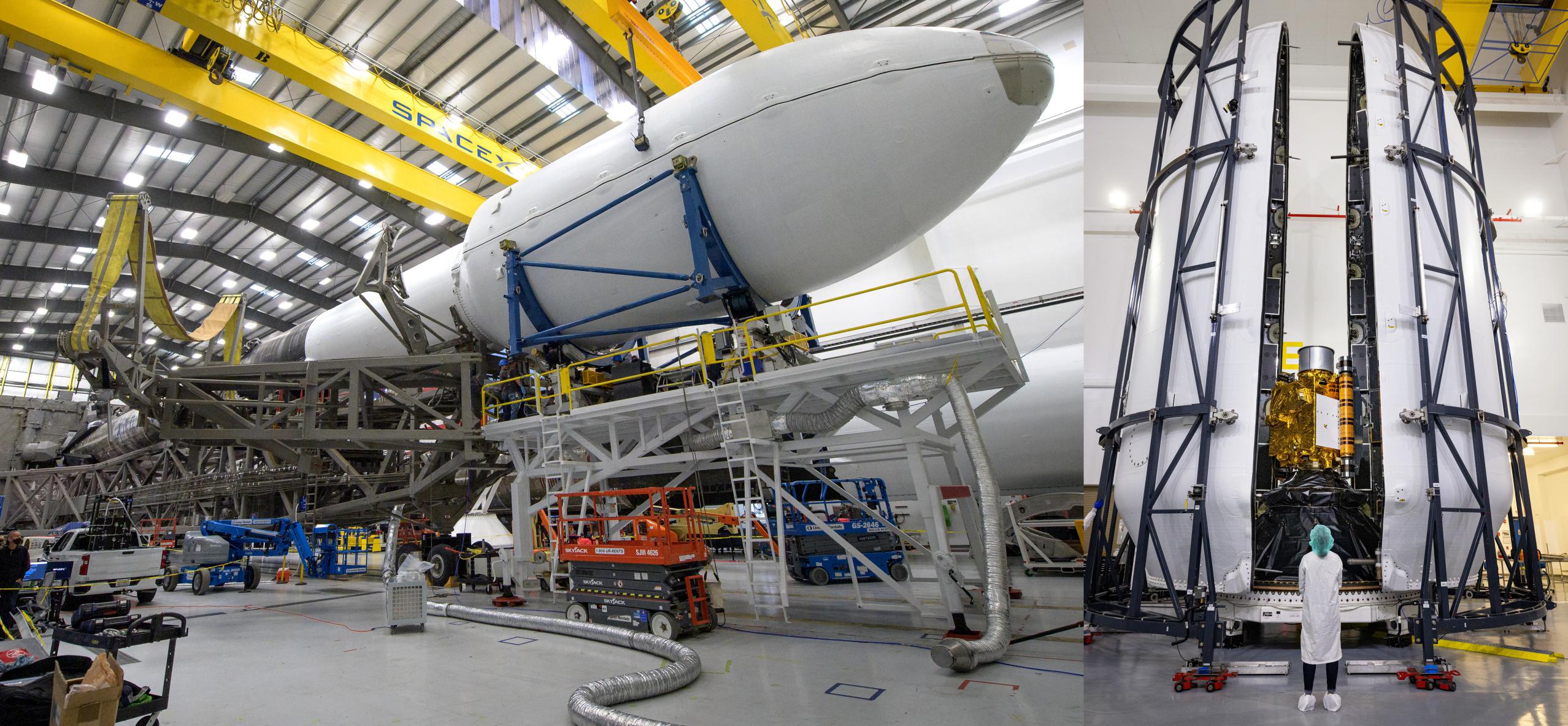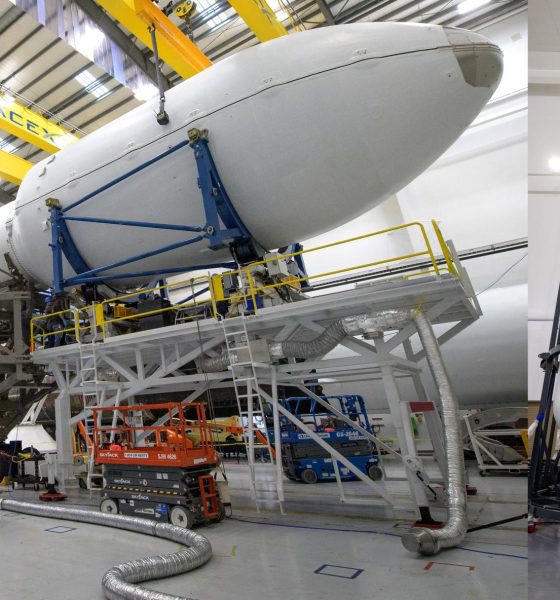NASA says SpaceX has finished encapsulating its DART asteroid redirection spacecraft inside Falcon 9’s fairing and opened up its West Coast launch pad hangar to give VIPs and mission team members a tour of their rocket.
Measuring 70m (230ft) tall, 550 metric tons (1.2M lb) fully fueled, and capable of producing more than 775 tons (1.71M lbf) of thrust at liftoff, Falcon 9 remains on track to launch NASA’s Double Asteroid Redirection Test mission no earlier than 10:21 pm PST, Wednesday, November 23rd (06:21 UTC 24 Nov). While there are multiple conflicting reports of the spacecraft’s launch mass, it will likely weigh between 600 and 650 kg (1300-1450 lb) – a minuscule 0.1% of the rocket’s total mass at liftoff. In simpler terms, Falcon 9 launching DART is a bit like a semi-truck carrying a single piece of wood.
Nevertheless, just like that semi-truck scenario, it might not be the most efficient choice of vehicle but sometimes a one-size-fits-all rocket like Falcon 9 can make a lot of sense.
Notably, despite being outsized by at least a factor of 2-3, Falcon 9’s DART launch will ultimately cost NASA about $73M – about a quarter of the mission’s total ~$250M cost. Nominally headed to interplanetary space, there isn’t a smallsat launcher (i.e. Firefly Alpha, Relativity Terran-1, Virgin Orbit LauncherOne, ABL Space RS-1, etc.) currently in development that’s expected to be able to launch a ~600 kg payload onto the interplanetary trajectory Falcon 9 will send DART on. If there were, it might theoretically cost NASA just ~$20M to launch DART but it will also take years for any of the new small to midsize rockets that might have enough performance to establish a track record of reliability, meaning that NASA would have to accept significant risk for that potential discount.

It’s worth noting that based on several comments from executives indicating that a flight-proven Falcon 9 costs about $15-25M to launch, SpaceX could almost certainly charge NASA half as much to launch DART while still breaking even, with its routine reusability making the potential economic advantage of smaller rockets much murkier. Additionally, despite the potential to save another $30-50M, NASA is still likely saving at least $80-100 million by launching on a $73M Falcon 9 rocket rather than the United Launch Alliance’s (ULA) cheapest Atlas V offering, which NASA has paid around $150-175M for in recent years.
While SpaceX has technically launched two similarly tiny NASA payloads to very high orbits ~300,000 and ~900,000 km (150,000-600,000 mi) away from Earth in 2015 and 2018, as well as CEO Elon Musk’s Tesla Roadster on an Earth escape trajectory with Falcon Heavy, data from JPL recently confirmed that DART will be Falcon 9’s first truly interplanetary launch. After reaching a normal low Earth parking orbit, Falcon 9’s expendable upper stage will ultimately boost the small spacecraft free of Earth’s gravity, sending it into a heliocentric orbit that will eventually intersect with the binary Didymos-Dimorphos asteroid system.
As early as September 2022, DART will slam into asteroid moon Dimorphos while traveling a staggering 6.6 kilometers per second (4.1 mi/s) in an attempt to shift its orbit around the larger Didymos asteroid. In effect, NASA is using the asteroid system a bit like an isolated sandbox to (hopefully) exaggerate any effects. If successful, DART will prove that kinetic impactors offer a viable way to change the course of asteroids and comets, potentially paving the way for the creation of a true planetary defense program.

News
Elon Musk’s Grok AI to be used in U.S. War Department’s bespoke AI platform
The partnership aims to provide advanced capabilities to 3 million military and civilian personnel.

The U.S. Department of War announced Monday an agreement with Elon Musk’s xAI to embed the company’s frontier artificial intelligence systems, powered by the Grok family of models, into the department’s bespoke AI platform GenAI.mil.
The partnership aims to provide advanced capabilities to 3 million military and civilian personnel, with initial deployment targeted for early 2026 at Impact Level 5 (IL5) for secure handling of Controlled Unclassified Information.
xAI Integration
As noted by the War Department’s press release, GenAI.mil, its bespoke AI platform, will gain xAI for the Government’s suite of tools, which enable real-time global insights from the X platform for “decisive information advantage.” The rollout builds on xAI’s July launch of products for U.S. government customers, including federal, state, local, and national security use cases.
“Targeted for initial deployment in early 2026, this integration will allow all military and civilian personnel to use xAI’s capabilities at Impact Level 5 (IL5), enabling the secure handling of Controlled Unclassified Information (CUI) in daily workflows. Users will also gain access to real‑time global insights from the X platform, providing War Department personnel with a decisive information advantage,” the Department of War wrote in a press release.
Strategic advantages
The deal marks another step in the Department of War’s efforts to use cutting-edge AI in its operations. xAI, for its part, highlighted that its tools can support administrative tasks at the federal, state and local levels, as well as “critical mission use cases” at the front line of military operations.
“The War Department will continue scaling an AI ecosystem built for speed, security, and decision superiority. Newly IL5-certified capabilities will empower every aspect of the Department’s workforce, turning AI into a daily operational asset. This announcement marks another milestone in America’s AI revolution, and the War Department is driving that momentum forward,” the War Department noted.
News
Tesla FSD (Supervised) v14.2.2 starts rolling out
The update focuses on smoother real-world performance, better obstacle awareness, and precise end-of-trip routing, among other improvements.

Tesla has started rolling out Full Self-Driving (Supervised) v14.2.2, bringing further refinements to its most advanced driver-assist system. The new FSD update focuses on smoother real-world performance, better obstacle awareness, and precise end-of-trip routing, among other improvements.
Key FSD v14.2.2 improvements
As noted by Not a Tesla App, FSD v14.2.2 upgrades the vision encoder neural network with higher resolution features, enhancing detection of emergency vehicles, road obstacles, and human gestures. New Arrival Options let users select preferred drop-off styles, such as Parking Lot, Street, Driveway, Parking Garage, or Curbside, with the navigation pin automatically adjusting to the user’s ideal spot for precision.
Other additions include pulling over for emergency vehicles, real-time vision-based detours for blocked roads, improved gate and debris handling, and extreme Speed Profiles for customized driving styles. Reliability gains cover fault recovery, residue alerts on the windshield, and automatic narrow-field camera washing for new 2026 Model Y units.
FSD v14.2.2 also boosts unprotected turns, lane changes, cut-ins, and school bus scenarios, among other things. Tesla also noted that users’ FSD statistics will be saved under Controls > Autopilot, which should help drivers easily view how much they are using FSD in their daily drives.
Key FSD v14.2.2 release notes
Full Self-Driving (Supervised) v14.2.2 includes:
- Upgraded the neural network vision encoder, leveraging higher resolution features to further improve scenarios like handling emergency vehicles, obstacles on the road, and human gestures.
- Added Arrival Options for you to select where FSD should park: in a Parking Lot, on the Street, in a Driveway, in a Parking Garage, or at the Curbside.
- Added handling to pull over or yield for emergency vehicles (e.g. police cars, fire trucks, ambulances).
- Added navigation and routing into the vision-based neural network for real-time handling of blocked roads and detours.
- Added additional Speed Profile to further customize driving style preference.
- Improved handling for static and dynamic gates.
- Improved offsetting for road debris (e.g. tires, tree branches, boxes).
- Improve handling of several scenarios, including unprotected turns, lane changes, vehicle cut-ins, and school buses.
- Improved FSD’s ability to manage system faults and recover smoothly from degraded operation for enhanced reliability.
- Added alerting for residue build-up on interior windshield that may impact front camera visibility. If affected, visit Service for cleaning!
- Added automatic narrow field washing to provide rapid and efficient front camera self-cleaning, and optimize aerodynamics wash at higher vehicle speed.
- Camera visibility can lead to increased attention monitoring sensitivity.
Upcoming Improvements:
- Overall smoothness and sentience.
- Parking spot selection and parking quality.
News
Tesla is not sparing any expense in ensuring the Cybercab is safe
Images shared by the longtime watcher showed 16 Cybercab prototypes parked near Giga Texas’ dedicated crash test facility.

The Tesla Cybercab could very well be the safest taxi on the road when it is released and deployed for public use. This was, at least, hinted at by the intensive safety tests that Tesla seems to be putting the autonomous two-seater through at its Giga Texas crash test facility.
Intensive crash tests
As per recent images from longtime Giga Texas watcher and drone operator Joe Tegtmeyer, Tesla seems to be very busy crash testing Cybercab units. Images shared by the longtime watcher showed 16 Cybercab prototypes parked near Giga Texas’ dedicated crash test facility just before the holidays.
Tegtmeyer’s aerial photos showed the prototypes clustered outside the factory’s testing building. Some uncovered Cybercabs showed notable damage and one even had its airbags engaged. With Cybercab production expected to start in about 130 days, it appears that Tesla is very busy ensuring that its autonomous two-seater ends up becoming the safest taxi on public roads.
Prioritizing safety
With no human driver controls, the Cybercab demands exceptional active and passive safety systems to protect occupants in any scenario. Considering Tesla’s reputation, it is then understandable that the company seems to be sparing no expense in ensuring that the Cybercab is as safe as possible.
Tesla’s focus on safety was recently highlighted when the Cybertruck achieved a Top Safety Pick+ rating from the Insurance Institute for Highway Safety (IIHS). This was a notable victory for the Cybertruck as critics have long claimed that the vehicle will be one of, if not the, most unsafe truck on the road due to its appearance. The vehicle’s Top Safety Pick+ rating, if any, simply proved that Tesla never neglects to make its cars as safe as possible, and that definitely includes the Cybercab.










